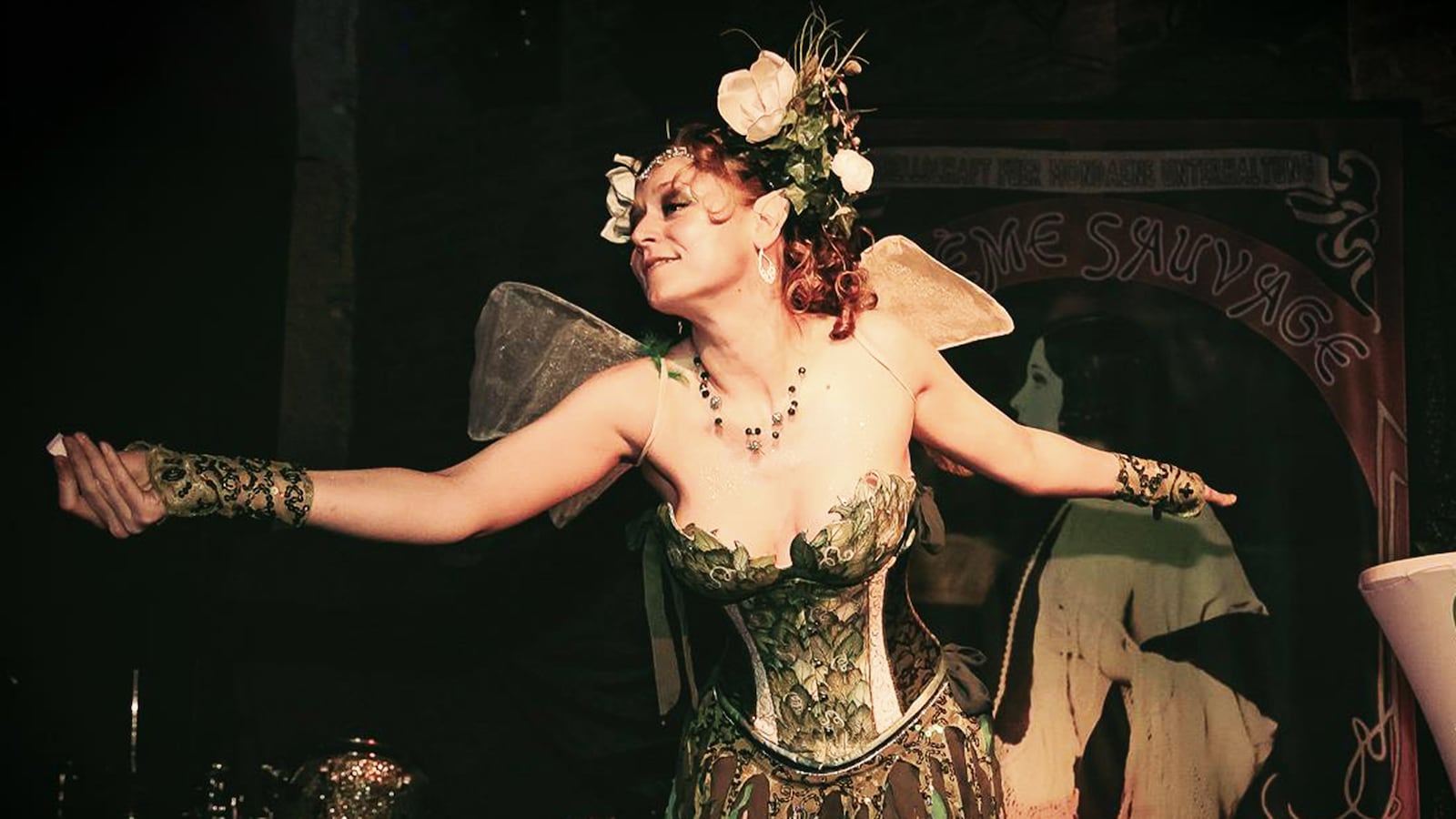Like most first-time visitors to Berlin, I came to the German capital in search of a party. Conjuring the Weimar spirit, an art-nouveau flyer for Boheme Sauvage led me to a pillared playhouse and group of flappers and dandies armed with a secret code. Inside was an evening of vaudeville, complete with cabaret piano man, an absinthe fairy serving green spirits, and a va-va-va-voom burlesque dancer removing layer after layer of costumed extravagance onstage until all that remained were be-tasseled pasties.
Berliners don’t party in half measures. They love costumes, historical and histrionic.
The city’s reputation as a European epicenter for fetish and fantasy is part of what draws more than 12 million tourists per year; but locals know that hedonism is only the beginning. Party performances like drag and burlesque are as political as they are entertaining, thanks to a culture of subcultures that champions queer, minority, women, and gender-non-conforming performers on safe stages and in party zones tightly controlled by discerning (or, some might say, discriminatory) bouncers. In this environment, anyone can feel empowered to express themselves.
“I’m going to show you tits, but they come with a mouth and the mouth’s got something to say” neo-burlesque performer Lilly Mortis says of her darkly comic feminist clown characters. “You’re allowed to have a personality and a body, and you shouldn’t have to make a choice between the two.”

Lilly Mortis
FacebookLilly (her performer-pseudonym) refuses to choose between identities, mixing glam into her daylight hours. When I met her for an afternoon coffee, she sported a sophisticated pirate look in Moroccan harem pants, chunky jewelry and makeup with just a little sparkle; when German-born Lilly takes on her English performer-persona, her natural features disappear under a porcelain-white painted face, massive eyelashes, and a variety of handmade wigs and hats.
In the female-driven and feminist world of Berlin burlesque, Lilly’s “sweet” characters ultimately reveal themselves to be freaky and even dangerous, interrogating the audience’s expectations rather than capitulating to them, sometimes by using gender role reversals. One character she calls the “Slutty Latex Murder Clown” lures a man from the audience on stage for a lap dance, only to break his neck and play with his body. “It’s my version of #MeToo, which is #YouToo... Making you [men] feel a little bit of the horror that women who walk home with their keys between their fingers know.”

Lilly Mortis
FacebookDrag performance, while coming from a different set of political motivations, questions identity and gender expectations in the same way. Hosting a recent drag show, House of Presents, American-born tattooed activist-queen Pansy, in a corset, brunette wig, and the tiniest of ripped jean shorts, asked for a show-of-hands of straight people in the audience. “Some of you felt a little uncomfortable raising your hands just now, and that’s what it’s like to walk out into the world and be queer every day, so thank you for being here and supporting us,” she preached from the pole. Pansy's Tuesday night show at divey neon karaoke bar Monster Ronson’s (open daily from 7pm), in the hip Friedrichshain neighborhood, draws a delightfully mixed crowd wearing anything from street clothes to drag makeup.
Shakespeare is credited with coining the term “drag,” shortened from the phrase “Dressed resembling a girl,” and although it is still mostly associated with men appropriating a female persona, drag performers in Berlin don’t merely impersonate women, they purposely blur gender markers and actually deconstruct the concept of the feminine. Pansy, for one, is not afraid to reveal her plastic boobs or the layers of her costume on stage. Similarly, one of the city’s longest-reigning queens, Gloria Viagra, is an impossibly-tall blonde bombshell who sports a thick natural mustache; fashion and design artist Hunger, who uses body paint and burlesque-style striptease in self-described “distorted drag,” eschews the question of gender altogether.

Men dressed as women at the Eldorado nightclub on Motzstrasse, 1929.
Herbert Hoffmann/Getty ImagesA Century of Decadence (almost)
That’s why a century of writers have called Berlin avant-garde, starting with Christopher Isherwood. Back in the 1920s, decadent gay balls and lesbian nights at the El Dorado club provided community to queers, while mainstream Weimar nightlife, full of burlesque and drag, welcomed everyone. Although strange and playful characters never completely disappeared from Berlin, extravagant costumes and wild parties were in short supply for obvious reasons starting in the mid-1930s.
Drag began to resurface in 1970s West Berlin at Chez Romy, a gay club frequented by glam rock celebs like David Bowie and Freddie Mercury, who bridged the gap between drag and the “masculine” rock music genre. By the 1990s, drag queens were a major part of the early queer-positive techno scene. A decade later, burlesque made its comeback, starting with Boheme Sauvage parties at vintage venues like Ballhaus Berlin, a 1905 dancehall open most weekend, in the center of Mitte, where numbered 1930s telephones at each table allowed old-fashioned flirting by phone long before the advent of texting and Tinder.
The spectrum of performers in both of these circuits ranges from high glamour to low-brow, with costumes and looks that can include elaborate gowns, or creative inspiration supported by dumpster-diving. A popular variety venue in the 1890s, Wintergarten Variety Theatre, was rebuilt in 1992 as an Art Deco performance hall in Mitte, and now hosts some of the larger burlesque events in the city. On September 22 and 23, it will be home to the 8th annual Vaudeville Variety Review, a vintage cabaret with couture burlesque and acrobatic performers, envisioned by stylish burlesque queen Sheila Wolf. “She’s basically Dita von Teese on acid,” Lilly says. Sheila, a middle-aged father by day, shines in see-through dresses by night, creating a seamless sequined synthesis of burlesque and drag. Berlin continues to live up to its reputation of defying the present and moving us all into the future.
More than Skin-Deep
But even as these artists question gender, the nudity implied in burlesque - and often in drag—reminds audiences that yes, gender still exists. And that’s okay, too.
As Martini Cherry Furter, an enviably tall, black, French queen based in Berlin, sashays around the stage in a sparkling dress at House of Presents, the lip-syncing picks up steam. Soon enough, the whole costume disappears, and a tucked-away penis comes tumbling out, to the crowd’s delight. After the performance, Miss Pansy ushers Martini back to the stage for a demonstration-based lesson in “tucking”.
While gay men in drag may use nudity as comedy and caricature, burlesque performers appreciate the control and distance of the stage.
“Stripping… comes from a completely different side of it. Stripping answers to the male gaze in that it gives the audience, men, what they want to see, and very quickly. While in burlesque, in what I do, it’s turning it around: not showing what wants to be seen, hiding what people want to see, and giving somebody something completely different than what they thought they were in for,” explains Lilly, whose burlesque shows usually reveal layers of costumes rather than a lot of skin.

La Fee Verte, a burlesque artist and producer of the monthly show Frack and Spitzenhöschen at Ballhaus Berlin, sews her own magical Mucha-inspired art deco costumes, which range from comical and cartoonish to fairytale-fancy. Like Lilly, she sees the art of the reveal as a way to show layers of costume underneath, although her costumes do ultimately reveal a lot of skin.
The only thing this French fairy, known by day as German actress Maja Makowski, carries with her from the first song until the end of a burlesque performance is the mischievous smile of the “shy” La Fee Verte. But she maintains that the nudity aspect is no longer uncomfortable for her. “In a certain environment it’s totally normal to be barely dressed and you don’t feel naked. In every stage of undressing I feel protected.” The respect of the audience creates a safe distance. The illusion of her character, too, provides a cathartic output: La Fee Verte “has elements of me, elements that I normally wouldn’t show. So it’s a way of expressing a part of myself that is not really my everyday personality.”

La Fee Verte
Johannes FrankeActivism from Night to Day
Farce and parody is quintessential to burlesque, too: the word comes from the Italian burla, meaning a joke or mockery, and the original burlesque variety shows featured women in feminized men’s uniforms who mocked the patriarchy. Some performers embrace it. Burlesque girl Bana-banana, whose unmissable pink-orange hair is almost as flamboyant as she is, spent one performance ripping off a dress made of newspaper headlines while lamenting the West’s response to the migrant crisis.
However, outright activism is more fully at home in drag, which brings visibility to queer people. Although Lilly Mortis expresses feminist and political views in her shows too, she doesn’t credit herself with being a drag artist. “I don’t feel I’m in a position to claim something like drag because it doesn’t belong to me. I’m still a cis woman. And there’s a long history of drag queens fighting very hard against pressure from all different sides to establish their art form,” she says.
For some queens, activism isn’t just inherent in the art itself, it is also the subject. Olympia Bukkakis, a non-binary, transgender, trash-drag-intellectual, co-hosts Queens Against Borders, which bills a unique variety of artists for “a performance party in solidarity with trans and queer refugees.” The tall, leggy, bald Australian, alternating between flowing white dresses and black Grim Reaper garb, co-hosted the latest Queens show at a grungy punk club in Kreuzberg, SO36, which looks like a college party from the 90s that never ended. The March edition featured queens from Syria, Iraq, Jordan, and Lebanon, shedding layers of belly-dancing costumes while lip-syncing Middle Eastern songs to an Arabic-, English-, and German-speaking audience. Diva Maguy, the show’s co-host, is a trans-woman and a migrant from Lebanon who performed in a stylish, lacy faux-hijab, and provocatively shed layers down to her belly-dancing beads.
Before the show, Olympia and Maguy invited performers on stage for a political discussion to talk about their experiences as trans and queer immigrants in Berlin. For Diva Maguy, who often faces discrimination on the streets of Berlin, too, safe spaces for queer performance art are important, but they don’t replace the need for her to be a daytime activist.
Pansy agrees. “For me it’s really important to take drag outside of the club, into the real world because we are a legitimate amazing art form, to bring drag into the daylight,” she told her Monster Ronson’s crowd. For pride week, Pansy hosts a literal high-heeled “drag race” across the Oberbaum Bridge, where queens clobber their way over the water.
Burlesque artists have their own reasons for championing visibility: reclaiming a female gaze, and promoting body positivity. Earlier this summer, a gaggle of corset-clad burlesque girls formed a flash mob photo shoot on the u-bahn, orchestrated by photographer Zora Jurenkova. They surprised a group of football fans heading to a national game, and delighted in bringing performance art out of the clubs and into the daylight.
But ultimately, does it matter whether the costume is burlesque or drag, or who is underneath? “What we’ve got in common is hyper-femininity,” Lilly says. “Ultimately, it doesn’t matter what body is underneath this huge costume. It’s not binary. It will look relatively similar, from an outside perspective. On the inside, though, I think it comes from very different places.”
Lilly Mortis can be seen next with her new burlesque troupe, the Velvet Creepers, on September 8. You can see Le Fee Verte in her own show, Frack und Spitzhöschen, on September 21 and on October 18 at the Berlin Burlesque Festival. Pansy hosts House of Presents at Monster Ronson’s every Tuesday night. Check out Silver Future, Toast Hawaii and Zum Starken August for other regular drag and burlesque events.






